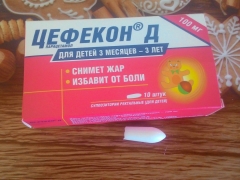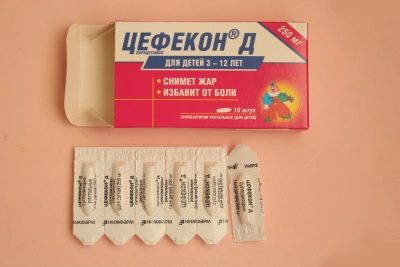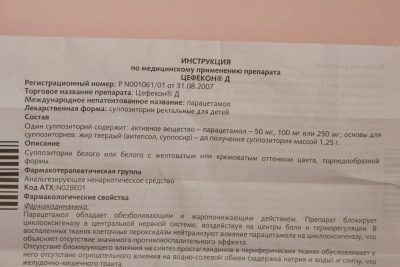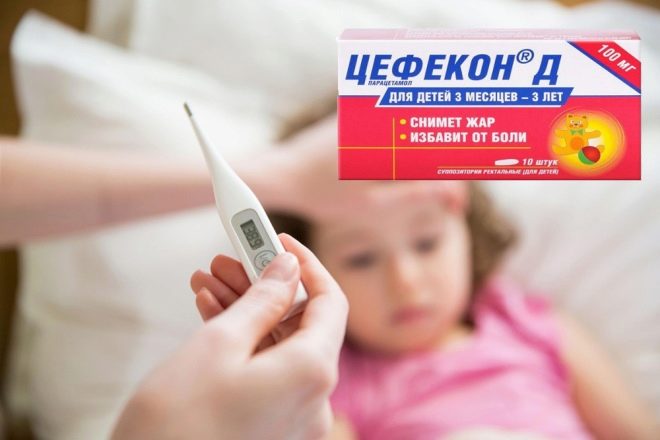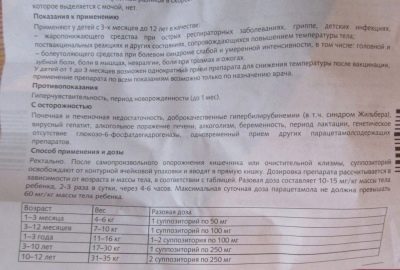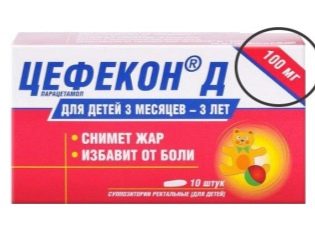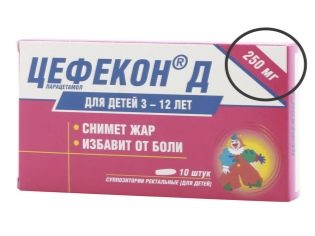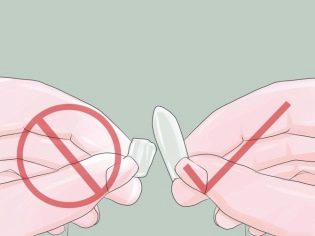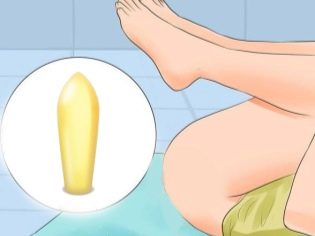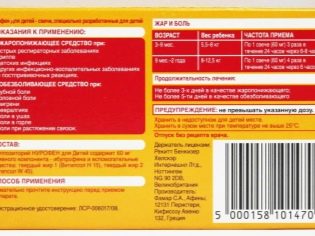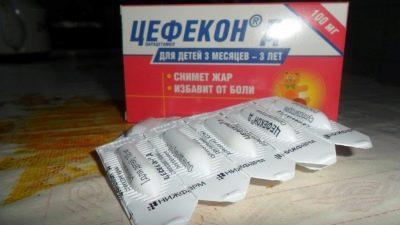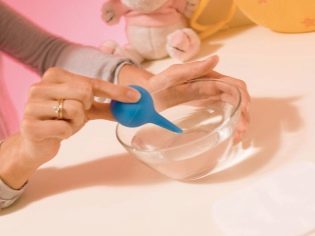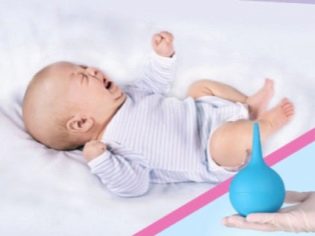Candles "Cefecon D" for children: instructions for use
Drugs that contain paracetamol, the most in demand for fever and pain in children. One of these drugs is Cefecone D. It is called a safe tool that effectively helps with pain, and with increasing body temperature. This medicine is convenient to use even in young patients, but in order for this medicine to effectively eliminate unpleasant symptoms and not cause side effects, it is necessary to know about the features of its use in childhood.
Release form
Tsefekon D is produced by the Russian company Nizhfarm only in one dosage form, which is rectal suppository. They have an elongated shape and white color with a yellow or cream shade. The drug is placed in a cellular package of 5 suppositories and is sold in boxes of 10 pieces.
Composition
Action "Tsefekona D" provides paracetamol, the dosage of which in one candle can be:
- 50 mg;
- 100 mg;
- 250 mg.
Additionally, the medication contains witepsol - the basis for suppositories, consisting of triglycerides of fatty acids. This ingredient is well stored and does not affect the active substance of the drug or the health of the patient.
Operating principle
Tsefekona D has properties to block cyclooxygenases that are found in the tissues of the central nervous system. Thanks to this mechanism of action, the drug affects the thermoregulation center (it has an antipyretic effect) and pain centers (reduces pain). The drug has no pronounced anti-inflammatory effect, but there is also no negative effect on the digestive tract, as well as on the exchange of water and electrolytes.
Absorption of paracetamol from the suppository occurs fairly quickly - the maximum concentration of this substance is determined in the blood 30-60 minutes after the injection of the candle into the rectum. Metabolic changes of the drug occur in the liver and more than 80% of the drug leaves the body with urine within one day after use.
Indications
“Tsefekon D” is most often used as an antipyretic medication when a child has an acute respiratory viral infection, childhood infection, influenza, a reaction to a vaccine or another condition that manifests itself with fever. Since suppositories also have an analgesic effect, they can be used for mild or moderate dental, muscle, headache, and other types of pain, including trauma, burns, or nerve inflammation.
From what age is prescribed?
"Tsefekon D" is contraindicated in children of the first month of life. If the baby is 1 to 3 months old, this medicine can be used if several conditions are met.
First of all, the doctor must prescribe candles, so the examination of the baby by a pediatrician is mandatory.
As a rule, the use of "Tsefekona D" at such an early age is required at elevated body temperature, which is a reaction to vaccination. In addition, the medication is used only once - if after a single use the temperature has not decreased, an additional examination of a small patient is required.
If the child is already 3 months old, the use of Tsefekona D is possible without a prescription, but consultation is still advisable. It is important to understand that this is only a symptomatic medicine, that is, it affects only certain symptoms, and the elimination of the cause of the disease may require the administration of other medicines, such as antibiotics. To choose the right dosage, you need to know how much a child weighs and how old he is.
In patients older than 12 years, this medicine is not used, since the content of the active substance even in suppositories with the highest dosage will not be sufficient for a therapeutic effect.
Contraindications
The drug is not prescribed to babies who have found hypersensitivity to paracetamol. Precautions in the treatment of "Cfecone D" require children with:
- kidney disease;
- anemia;
- Gilbert, Rotor or Dabin-Johnson syndrome;
- leukopenia;
- thrombocytopenia;
- liver disease.
Side effects
In some children, after the administration of the suppository, an allergic reaction may develop, for example, in the form of angioedema, pruritus or rash. Sometimes the use of "Tsefekona D" leads to nausea, abdominal pain or vomiting. In very rare cases, treatment with such suppositories adversely affects blood formation, liver condition, or kidney function. Typically, such a negative effect of the drug is noted with too long use of suppositories or exceeding the dosage recommended by age.
Instructions for use
"Cefecone D" is administered rectally, that is, the candle must be removed from the packaging and gently enter into the rectum. To the drug acted more quickly and caused the desired therapeutic effects, it is recommended to use after spontaneous emptying or enema.
The dose and mode of administration, as noted above, is determined on the basis of the child’s body weight and age. On average, a single dosage is from 10 to 15 mg of paracetamol per kilogram of baby weight. For example, if a child weighs 8 kg, then he is given 1 suppository, each with a dosage of 100 mg, since the single dose for such a patient should be 80-150 mg.
In the paper annotation, which is sold with candles, there is a table with approximate dosages for children of different ages, taking into account their weight.
"Cefecone D" with the lowest content of paracetamol is used mainly in infants 1-3 months. But this medicine can also be used in older infants, if their weight is less than 7 kg. For karapuzov with a body weight of 7-10 kg (usually this weight happens in 3-12 months), suppositories containing 100 mg of the active ingredient are already required.
For children of 1-3 years old, who weigh from 11 to 16 kg, they also buy candles with a dosage of 100 mg, but at this age a single dose can already be 100-200 mg, that is, it is permissible to administer two 100 mg suppositories at once. The drug with the highest content of paracetamol (250 mg) is indicated for the elimination of fever or pain in children over 3 years old, whose weight exceeds 17 kg. At the same time, at the age of 3-10 years, if the body weight is less than 30 kg, one candle will be a single dose, and patients of 10-12 years old with a weight of 30-35 kg are prescribed 2 suppositories (500 mg) at once.
In the indicated single dosages, “Cefecone D” can be used up to 3 times per day. Candles can be put with an interval of 4-6 hours. In one day, the child should not receive from suppositories more than 60 mg of active ingredient per 1 kg of its weight. So, for an infant that weighs 8 kg, a daily dosage of 480 mg (60x8) cannot be exceeded, that is, no more than 4 candles of 100 mg are given per patient per day.
As for the duration of the use of the drug, at high temperature, the drug is used for up to three days, and for the purpose of pain relief - up to 5 days.
If the child's body temperature on the fourth day remains high, and the pain on the sixth day from the start of treatment has not disappeared, then further treatment should be discussed with the doctor.
Overdose
If you accidentally use candles with a dosage that does not suit a small patient by age, this may lead to a decrease in appetite, nausea, abdominal pain, loose stools and other negative symptoms from the gastrointestinal tract. If an overdose is detected, a medical examination is recommended.
Interaction with other drugs
It is unacceptable to simultaneously give the child other paracetamol preparations (for example, in suspension), because this will increase the risk of overdose.Nor should Tsefekon D be alternated with other antipyretic drugs, for example, with Nurofen, unless such treatment was prescribed by a doctor. In addition, the drug is not prescribed with many other medications, including salicylates, barbiturates and anticoagulants. All incompatible with "Cefecon D" means noted in the abstract.
Terms of sale
Like other paracetamol-based drugs, Cefecone D can be bought without a prescription from a doctor. The average price of one pack of candles with a dosage of 50 mg is 35–45 rubles, suppositories containing 100 mg of paracetamol in a dose of 40 mg, and about 50–60 rubles must be paid for a package of 250 mg of candles.
Storage conditions
Shelf life "Tsefekona D" - 3 years. Until it expired, the medicine should be stored in a place hidden from children. Such a place should be dry and cool (storage temperature should not exceed +20 degrees).
Reviews
Over 90% of reviews on the use of "Tsefekona D" in children are positive. In them, parents confirm the high efficiency of such candles, both at high body temperature, and with slight pain. The benefits of this drug also include its availability and low cost.
According to mothers, it is convenient to use just such a dosage form in both infants and older children, if they cannot take the drug by mouth (for example, they have severe nausea or the vomiting reflex is enhanced). They praise the drug and the parents of children with allergies, as the suppositories do not contain dyes, flavors and other chemical additives, which are in antipyretic syrups, suspensions and tablets.
Among the minuses of "Tsefekona D" sometimes note that the candle begins to act only after some time (in some children - as much as an hour), while the effect of oral forms can be replaced after 15-20 minutes.
In addition, for a sufficient therapeutic effect, the intestines of the child must be cleared of fecal masses, which in some cases compels the infant to additionally give an enema.
Analogs
If it is required to replace "Cefecone D" with a preparation with the same composition, then most often choose Paracetamol suppositories. They are also available in several dosages, and in the lowest (50 mg) are prescribed for children older than a month with the same indications. Other paracetamol suppositories contain more active substance, therefore they are prescribed from 3 months of age (“Efferalgan"At a dosage of 80 mg) or children older than 6 months (" Children's Panadol "at a dosage of 125 mg).
Instead of candles at a temperature or pain, you can give the child other forms of paracetamol-based drugs, for example, “Kalpol” suspension or “syrup”Efferalgan". In addition, such agents can be replaced with antipyretic drugs that contain ibuprofen ("Nurofen", "Ibuprofen"). They are also available in suppositories and liquid forms and are prescribed to young patients with fever or complaints of pain over the age of 3 months.
For more detailed reviews on Tsefekon D candles and their analogues, see the following video.
